Accepted Scientific Name: Cleistocactus samaipatanus (Cárdenas) D.R.Hunt
Bradleya 5: 92 (1987)

Cleistocactus samaipatensis (Cleistocactus samaipatanus) Photo by: Julio C. García
Origin and Habitat: Cleistocactus samaipatanusSN|3762]]SN|3762]] occurs in the Santa Cruz Department (provinces of Florida, Cordillera and Vallegrande), as well as in Luis Calvo province of Chuquisaca. Bolivia.
Altitude range: 1,000 to 2,000 metres above sea level.
Habitat: Widespread on rocky outcrops in forests within seasonally dry inter-Andean valleys and lowlands. It is common throughout its range. There is no known threat to this species.
Synonyms:
See all synonyms of Cleistocactus samaipatanus
Description: Cleistocactus samaipatanusSN|3762]]SN|3762]] is a long, narrow columnar cactus with pale gold toothpick-like spines. It grows vigorously with large, bright red to pink-red flowers. The plant found in cultivation are quite variable, and the dissimilarity among seedlings spination and flowers colour may be considerable.
Habit: Plants shrubby, branching basally with several upright stems, forming open bushes up to 1,5 m tall and broad.
Stems: Rounded cylindrical, slender, erect, ascending, later decumbent, prostrate or pendent, lime green, 90-150 m long and (2,5-)3,5-4(-5) cm in diameter and many-ribbed.
Ribs: 14-17, low, rounded up to 2 mm high and 7 mm wide.
Areoles: Light brown tomentose, later naked, close together, 3-4 mm apart.
Radial spines: 13-22(-40) thin, sharp, needle shaped, unequal 4-30 mm long, whitish, pale gold, ashy-grey or brownish.
Flower: Diurnal, very showy bright red to pink-red, tubular, zygomorphic, strongly S-shaped about 3,5-5 cm long and 2-2,5 in diameter. Corolla slightly compressed. Tepals linear strongly oblique, acute scarlet up to 15 mm long. Tube basally woolly and laterally compressed. Stamens in two rows, exerted with dark purple anthers. Stylus usually not or only slightly protruding, stigma lobes greenish-white to cream coloured.
Blooming season: With optimal growing condition it flowers time by time from late winter to nearly autumn, with a peak in March (other species of Cleistocacti also tend to flower this month)
Fruits: Small spherical 9-11 mm long and 7-9 mm wide, reddish, with dense white and brown wool.
Seeds: Tiny, blackish-brown or black.
Subspecies, varieties, forms and cultivars of plants belonging to the Cleistocactus samaipatanus group
Bibliography: Major references and furrther lectures
1) Edward Anderson “The Cactus family” Timber Press, Incorporated, 2001
2) James Cullen, Sabina G. Knees, H. Suzanne Cubey "The European Garden Flora Flowering Plants: A Manual for the Identification of Plants Cultivated in Europe, Both Out-of-Doors and Under Glass" Cambridge University Press, 11/Aug/2011
3) Cactus and Succulent Journal. Band 23, S. 91, Los Angeles 1951
4) Bradleya. Band 5, S. 92, 1987
5) David R Hunt; Nigel P Taylor; Graham Charles; International Cactaceae Systematics Group. "The New Cactus Lexicon" dh books, 2006
6) Curt Backeberg “Die Cactaceae: Handbuch der Kakteenkunde” 2. ed.. Volume 2, Gustav Fischer Verlag, Stuttgart New York 1983
7) Walther Haage “Kakteen von A bis Z” 3. ed. Quelle & Meyer Verlag, Heidelberg 1986
8) Lowry, M. 2013. Cleistocactus samaipatanus. The IUCN Red List of Threatened Species. Version 2014.2. <www.iucnredlist.org>. Downloaded on 13 August 2014.
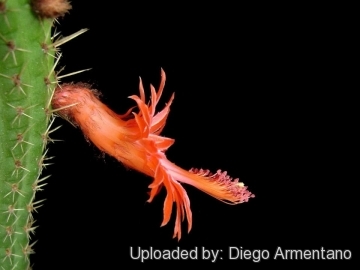 Cleistocactus samaipatensis (Cleistocactus samaipatanus) Photo by: Diego Armentano
Cleistocactus samaipatensis (Cleistocactus samaipatanus) Photo by: Diego Armentano Cleistocactus samaipatensis (Cleistocactus samaipatanus) Photo by: Julio C. García
Cleistocactus samaipatensis (Cleistocactus samaipatanus) Photo by: Julio C. García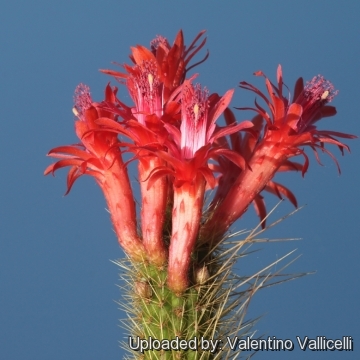 Cleistocactus samaipatensis (Cleistocactus samaipatanus) Photo by: Valentino Vallicelli
Cleistocactus samaipatensis (Cleistocactus samaipatanus) Photo by: Valentino Vallicelli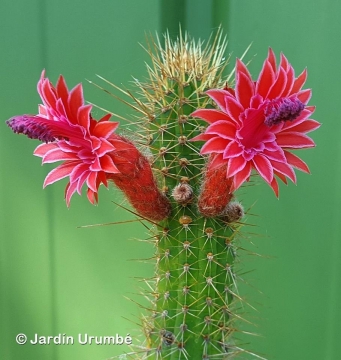 Cleistocactus samaipatensis (Cleistocactus samaipatanus) Photo by: Alexander Arzberger
Cleistocactus samaipatensis (Cleistocactus samaipatanus) Photo by: Alexander Arzberger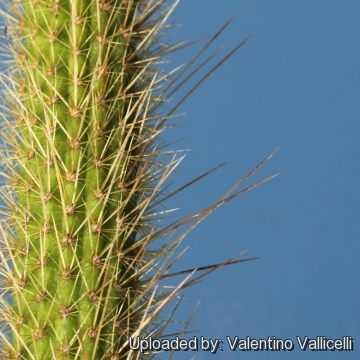 Cleistocactus samaipatensis (Cleistocactus samaipatanus) Photo by: Valentino Vallicelli
Cleistocactus samaipatensis (Cleistocactus samaipatanus) Photo by: Valentino Vallicelli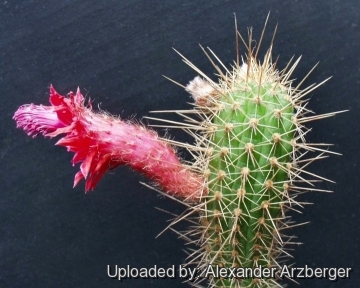 Cleistocactus samaipatensis (Cleistocactus samaipatanus) Photo by: Alexander Arzberger
Cleistocactus samaipatensis (Cleistocactus samaipatanus) Photo by: Alexander Arzberger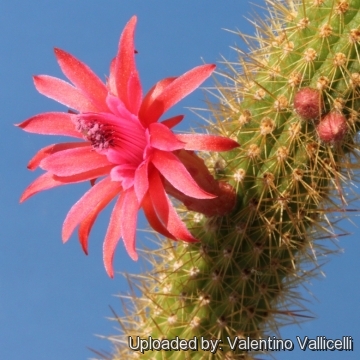 Cleistocactus samaipatensis (Cleistocactus samaipatanus) Photo by: Valentino Vallicelli
Cleistocactus samaipatensis (Cleistocactus samaipatanus) Photo by: Valentino Vallicelli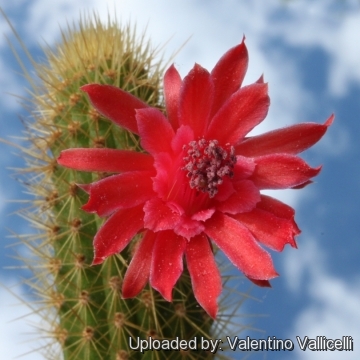 Cleistocactus samaipatensis (Cleistocactus samaipatanus) Photo by: Valentino Vallicelli
Cleistocactus samaipatensis (Cleistocactus samaipatanus) Photo by: Valentino VallicelliCultivation and Propagation: Cleistocactus samaipatanusSN|3762]]SN|3762]] is of easy culture, which makes it a good cactus for beginners. It suited to hanging baskets as well as pots.
Soil: Use a loose well drained cactus mix.
Repotting: Since they are rapid growers need plenty of space for their roots, repotting with fresh potting-mix should be done every other year or when the plant has outgrown its pot. However, repotting doesn't necessarily mean they'll need larger containers.
Sun Exposure: Require filtered bright light, partial sun or light shade, but not in full sun that will sunscald it.
Watering: They require moderately watering through the growing season. This can be done weekly or more frequently during the summertime, if the weather is sunny enough, but allow to dry fully before watering again. Kept this way, plants will show a healthy growth. Keep rather dry as soon as the temperature starts dropping in October and keep it dry in winter. The plant survives outside without protection in winter (cold hardy to -2° ) but is then somewhat prone to rot, too.
Fertilization: Give an occasional high potassium liquid feed during the active growing period.
Hardiness: Winter care presents no problems at temperatures from 5 to 15 degrees centigrade with plenty of light, but frost hardy to -2°C for short periods if very dry. This plant needs a period of cool rest in winter to produce flowers abundantly. It flowers freely indoors too if conditions suit it.
Pest and diseases: They are generally fairly easy to grow, especially if kept pest-free. They are susceptible to, scale insects and spider mite. Watch carefully for infestations of stem and root mealy bugs, and damage from these may well initiate fungal attack.
Propagation: Easy to propagate from cuttings or seeds. Take cuttings spring or summer, let them dry till the ends callous well. Then replant them in fresh cactus soil that is ever so slightly moist, and keep it that way till they root. Surface sowing is the best; seeds germinate in 14-28 days at 20° C , remembering that seedlings dislike strong light and dry conditions.
Your Photos

by Valentino Vallicelli
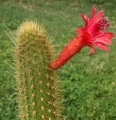
by Valentino Vallicelli
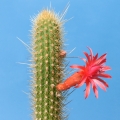
by Valentino Vallicelli





















